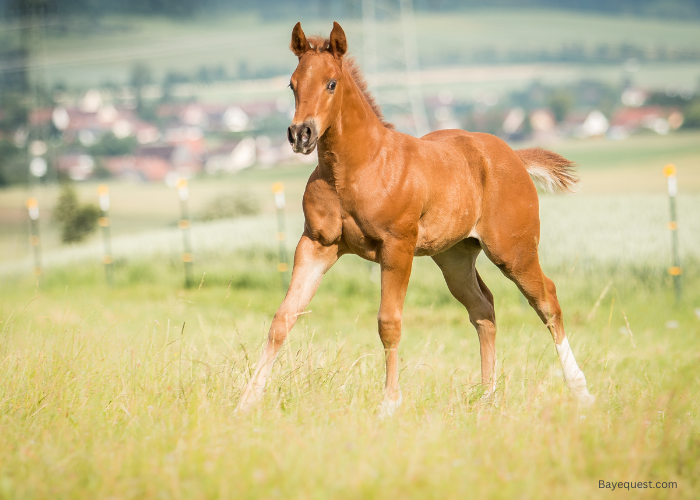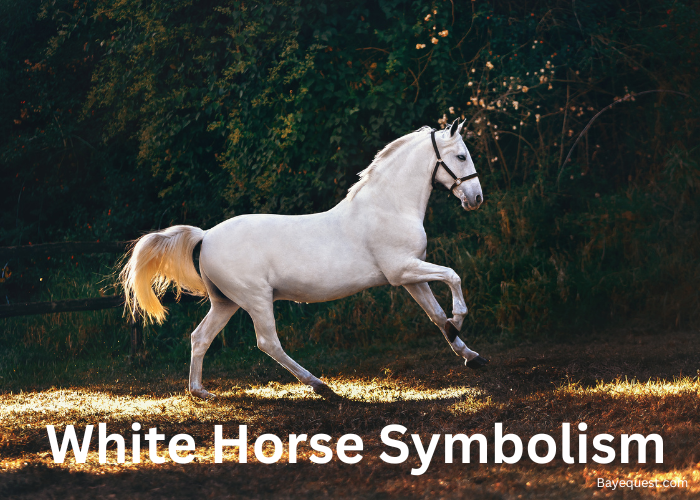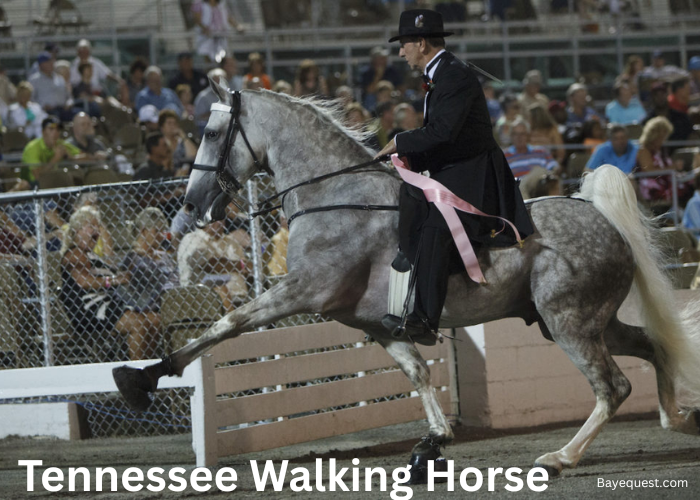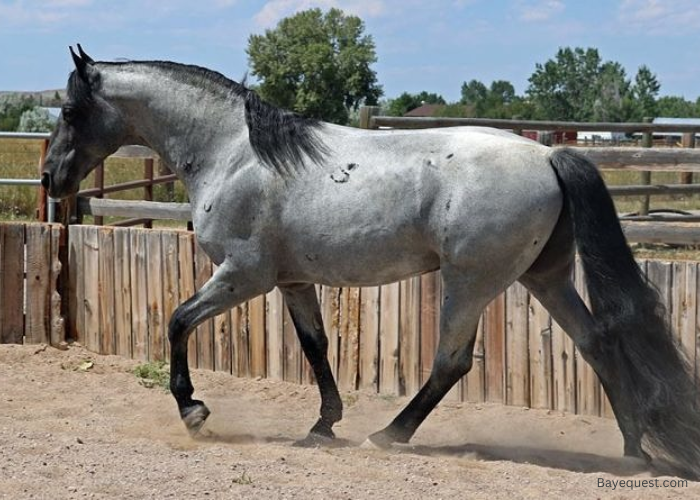Quarter Horses are loved for their speed and strength. But how long do these amazing horses live?
Their lifespan depends on many things, like care and health. Knowing what affects their longevity helps you keep them happy and healthy.
From their early years to their golden days, they deserve the best care. If you own a Quarter Horse or plan to get one, it’s important to understand their needs.
Let’s explore their lifespan and how to make their years as long and fulfilling as possible.
What is the Average Quarter Horse Lifespan? Key Takeaway
The average lifespan of a Quarter Horse is 25 to 30 years. Proper care, a balanced diet, regular exercise, and routine veterinary checkups can help them live longer. Factors like genetics, environment, and workload also play a role. With good management, some Quarter Horses can live well into their 30s.
What is a Quarter Horse?
A Quarter Horse is a popular and versatile horse breed. It is famous for its speed over short distances, especially a quarter mile.
These horses are strong, compact, and agile. They are often used for racing, ranch work, and rodeo events.
Quarter Horses are also great for casual riding and family activities. They are known for their calm temperament and intelligence.
This makes them easy to train and enjoyable to work with. Whether on a ranch or in an arena,
Quarter Horses are dependable and skilled.
Physical Characteristics of Quarter Horses
Quarter Horses are built for power and versatility. They have a compact, muscular body with a deep chest and strong, well-defined hindquarters.
These features give them the strength and speed they’re known for. Their heads are refined and balanced, with a straight profile, expressive eyes, and small, alert ears.
Typically standing 14 to 16 hands tall, they have a sturdy frame that supports their athleticism. Their legs are straight and strong, built for quick bursts of speed and agility.
Quarter Horses come in a wide range of colors, including sorrel, bay, black, and palomino, often with a smooth and glossy coat.
Their overall appearance is one of strength, balance, and readiness for action.
How Long Do Quarter Horses Live?
The average lifespan of a Quarter Horse is between 25 and 30 years. With proper care, some can live well into their 30s.
Factors like genetics, diet, exercise, and overall management play a big role in how long they live.
Horses that receive regular veterinary care, proper nutrition, and a stress-free environment often enjoy longer, healthier lives.
While their lifespan is similar to other horse breeds, Quarter Horses’ durability and adaptability make them reliable companions for many years.
A well-cared-for Quarter Horse can provide decades of joy and partnership.
Read also: What is the Average Lifespan of a Donkey?
Factors Affecting Quarter Horse Lifespan
A Quarter Horse’s lifespan depends on more than just genetics.
Understanding these factors helps you provide the best care and keep your horse healthy for as many years as possible.
Let’s explore what impacts their longevity the most.
Genetics
Genetics play a significant role in a Quarter Horse’s lifespan. Horses from healthy bloodlines are less likely to inherit genetic disorders or diseases.
Breeding practices that prioritize soundness and health contribute to longer lives.
However, even horses with excellent genetics need proper care to reach their full potential.
Diet and nutrition
Proper nutrition is crucial for a long and healthy life.
A balanced diet with quality forage, grains, and necessary supplements keeps the horse’s body strong and resilient.
Overfeeding or poor-quality feed can lead to obesity, colic, or metabolic issues, which shorten a horse’s lifespan.
Clean water and tailored diets for different life stages are also essential.
Exercise and workload
Regular exercise is vital for maintaining muscle tone, joint health, and mental well-being.
However, overworking a horse, especially at a young age, can lead to injuries or chronic conditions like arthritis.
A balanced workload that matches the horse’s fitness and age helps ensure long-term health and longevity.
Health care
Routine health care significantly impacts a Quarter Horse’s lifespan.
Regular veterinary checkups, vaccinations, dental care, and parasite control prevent many common health issues.
Early detection of problems can make a big difference in outcomes.
Neglecting these aspects can lead to preventable illnesses or conditions that shorten their lives.
Environment
A horse’s living environment directly affects its health and lifespan. Clean, safe, and spacious housing reduces the risk of injuries and infections.
Horses kept in pastures with good-quality grass and shelter are generally healthier.
Stressful or crowded conditions can weaken the immune system and lead to behavioral problems, both of which impact longevity.
A stable and nurturing environment promotes a healthier and happier life.
Common Health Issues in Quarter Horses
Quarter Horses are tough and dependable, but like any breed, they face their share of health challenges.
Here are some of the most common health concerns Quarter Horses may experience and how to address them.
1. Navicular syndrome
Navicular syndrome is a common condition affecting the horse’s front hooves, causing lameness.
It occurs due to inflammation or degeneration of the navicular bone and surrounding structures.
Proper hoof care and regular farrier visits can help prevent or manage this issue.
2. Arthritis
As Quarter Horses age, they are prone to arthritis, especially if they’ve had heavy workloads.
Joint inflammation can cause stiffness and pain, reducing mobility.
Maintaining a healthy weight and using joint supplements can help manage symptoms.
3. Laminitis
Laminitis is a painful condition affecting the tissues connecting the hoof to the foot.
It can result from obesity, overfeeding, or excessive stress on the hooves.
Quick treatment is essential to prevent long-term damage or severe complications.
4. Tying-up (Exertional Rhabdomyolysis)
Quarter Horses are susceptible to tying-up, a muscle condition caused by intense exercise, stress, or improper diet.
Symptoms include stiffness, sweating, and reluctance to move. A proper warm-up, balanced diet, and gradual increases in workload can help prevent it.
5. Skin conditions
Skin issues like rain rot, hives, and sunburn can affect Quarter Horses, especially those kept in humid or sunny environments.
Regular grooming and proper shelter help reduce these risks.
6. Respiratory issues
Due to dust or poor ventilation, Quarter Horses can develop respiratory problems like heaves or inflammatory airway disease (IAD).
Clean, well-ventilated stables and dust-free bedding are key preventive measures.
7. Gastrointestinal problems
Colic, ulcers, and other digestive issues are common in Quarter Horses. These can result from stress, irregular feeding schedules, or poor-quality feed.
Regular feeding, access to fresh water, and minimizing stress can reduce the risk.
8. Genetic disorders
Quarter Horses may inherit conditions like Hyperkalemic Periodic Paralysis (HYPP) or Polysaccharide Storage Myopathy (PSSM).
HYPP affects muscle function, while PSSM can lead to muscle stiffness and weakness.
Genetic testing and dietary adjustments can help manage these conditions.
9. Eye problems
Eye injuries and infections, such as conjunctivitis or uveitis, are common in Quarter Horses.
Prompt treatment is necessary to prevent long-term damage.
Tips to Maximize a Quarter Horse’s Lifespan
Taking care of a Quarter Horse is more than just feeding and grooming. It’s about creating the perfect balance of care, attention, and love to help them thrive.
Here’s how you can keep your horse happy, healthy, and by your side for as many years as possible.
Feed a balanced diet. Provide high-quality hay, grains, and supplements as needed. Match their diet to their age and activity level. Avoid overfeeding to prevent obesity.
Exercise regularly. Give them consistent, moderate exercise. This keeps their muscles strong and joints healthy. Don’t push them beyond their limits.
Schedule routine vet care. Take them for regular checkups. Keep vaccinations, dental care, and deworming up to date. Address health issues early.
Maintain hoof health. Schedule farrier visits every six to eight weeks. Balanced hooves prevent lameness and other problems.
Provide a safe environment. Keep their living space clean and spacious. Remove sharp objects and toxic plants. Provide shelter from extreme weather.
Monitor behavior and health. Watch for changes in appetite, movement, or attitude. Early action can prevent bigger problems.
Adjust care for older horses. Offer softer food and joint supplements. Reduce intense activities. Pay extra attention to their comfort.
Avoid overworking. Don’t push them too hard, especially when they’re young. Give them enough rest between activities.
Encourage social interaction. Horses need companions to stay mentally healthy. Allow them to bond with other horses.
Keep learning. Stay informed about horse care. Learn from experts and experienced horse owners. Adapt your approach as needed.
Quarter Horse Lifespan Comparison with Other Horse Breeds
How does the Quarter Horse lifespan compare to other breeds? Let’s find out.
| Horse Breed | Average Lifespan | Key Factors Influencing Lifespan |
| Quarter Horse | 25-30 | Genetics, care, and workload |
| Thoroughbred | 25-28 | Genetics, high stress from racing |
| Arabian | 30-35 | Robust health and sturdy build |
| Draft horse | 20-25 | Large size and joint stress |
| Pony | 30-40 | Smaller size, less strain on joints |
| Appaloosa | 25-30 | Hardy build, good care increases lifespan |
| Friesian | 16-20 | Susceptible to genetic disorders |
| Morgan | 30-35 | Strong health, adaptable to various climates |
| Standardbred | 25-30 | Durable with proper training and care |
| Mustang | 20-25 | Wild upbringing, resilient with proper care |
Famous Long-Lived Quarter Horses
Some Quarter Horses leave more than hoofprints—they leave legacies.
These famous horses not only lived long lives but also shaped the breed’s history with their achievements and influence.
Let’s look at some of the most notable long-lived Quarter Horses and their incredible contributions.
1. Doc Bar
Doc Bar, a legendary sire, lived to the age of 36 years. Known for revolutionizing the cutting horse industry, his strong genetics and excellent care contributed to his long life.
2. Poco Bueno
Poco Bueno, a Hall of Fame Quarter Horse, lived for 28 years. His influence on the breed through his exceptional performance and progeny is well-remembered.
3. Dry Doc
Dry Doc, a renowned cutting horse and sire, lived to 33 years. His contributions to the breed’s athleticism and versatility made him a standout.
4. King P-234
One of the most influential foundation sires, King lived to be 26 years old. Despite his shorter lifespan compared to others, his impact on Quarter Horse breeding is unmatched.
5. Skipper W
Skipper W, known for his exceptional conformation, lived to 31 years. His longevity is attributed to good genetics and excellent care.
6. Impressive
Impressive lived for 27 years and left a controversial but undeniable legacy. Despite carrying the HYPP gene, he remains one of the most well-known Quarter Horses.
7. Dash For Cash
Dash For Cash, a legendary racing Quarter Horse, lived to 27 years. His speed and influence on racing bloodlines have left a lasting legacy.
8. Peppy San Badger
Peppy San Badger, also known as “Little Peppy,” lived to 25 years. He was a top sire in cutting and is remembered for his incredible athleticism.
Signs of Aging in Quarter Horses
Aging is a natural part of life, even for the strong and dependable Quarter Horse.
While they may slow down with age, their wisdom and companionship make every moment special.
Recognizing the signs of aging helps you provide the extra care they need to stay comfortable and happy.
Here’s a closer look at what to watch for as your beloved horse enters their golden years:
Changes in coat texture and color
Their once-shiny coat may dull, and gray hairs might appear around the face or body. Seasonal shedding may also become irregular.
Weight and muscle tone loss
Older horses often lose muscle in their topline and may appear thinner overall, even with a proper diet.
Dental wear and tear
Worn-down teeth or missing molars can make chewing difficult, leading to slower eating or preference for softer feeds.
Slower movements
You might notice stiffness, especially in the mornings or after rest. Cold weather often worsens joint issues.
Hoof changes
Hoof walls may become more brittle, and growth can slow. Regular farrier care becomes even more critical.
Behavioral adjustments
Older Quarter Horses may become more reserved or show less interest in play. Some may also prefer quieter environments.
Reduced activity tolerance
Aging horses may tire faster during exercise or prefer lighter workloads.
Vision and hearing decline
Cloudy eyes and slower reactions to sound or movement can indicate aging-related sensory changes.
Immune system weakness
Frequent minor illnesses or slower recovery times suggest a less robust immune response.
Digestive sensitivities
Older horses may experience more frequent colic or have trouble digesting certain feeds.
Difficulty regulating body temperature
Your horse might need extra blankets in winter or more shade and water in summer to stay comfortable.
Changes in appetite
Some older horses eat less, while others develop a strong preference for specific feeds.
Quarter Horse Lifespan: Conclusion
Quarter Horses bring strength, loyalty, and joy to their owners. Understanding their needs helps them live a long and happy life.
Every stage, from their younger years to their golden days, is special. Proper care, attention, and love make all the difference.
You’re not just adding years to their life. You’re making those years better. Cherish the time you have with your Quarter Horse.
They will give you friendship and memories to last a lifetime.








